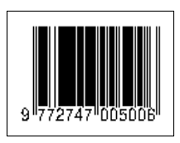TEACHERS' QUESTIONS IN ENGLISH LANGUAGE TEACHING (ELT) CLASSES
Abstract
Keywords
Full Text:
PDF (Bahasa Indonesia)References
Abubakar, B,S. Paramasivam, S. Imm, L.G., Sharmini, S. (2021) Interaction in the English language classroom: A review of teacher questions. Malaysian Journal of Social
an EFL classroom: promoting productive learning through teachers' questioning strategies. Studies in English Language and Education, 9(3),1019-1040 https://doi.org/10.24815/siele.v9i3.26072
Annisa,R.R., Nurlaila K., Hasanah, N. (2023). The use of questioning strategy in promoting students' critical thinking. ELTICS (English Language Teaching and English Linguistics) Journal 8(2), 69-79.
Avdic, A., Wissa, U. A., &Hatakka, M. (2016). Socratic flipped classroom: What types ofquestions and tasks promote learning? Proceedings of the EuropeanConference on E-Learning, 41-48.
Bata, K. W. (2020). Teachers' questioning strategies in Indonesian language learning. in 1st
International Conference on Language, Literature, and Arts Education (ICLLAE
(pp. 67-73). Atlantis Press. https://doi.org/10.2991/assehr.k.200804.013
Brown, H.D. (2007). Teaching by principles: An interactive approach to language pedagogy.
(3rd ed.). Pearson Education.
Dahlkwist, M. (2012). Uppdraglärarledarskap: Ledarskap, relationerochgrupprocesser. (1st.ed.). Liber.
Dayal, V. (2016). Questions. Oxford University Press.
Fox, B., & Thompson, S. (2010). Responses to wh-questions in English conversation. Research on Language and Social Interaction, 43(2), 133-156.
Gafaranga, J. (2000). Medium repair vs. other-language repair: Telling the medium of a bilingual conversation. International Journal of Bilingualism, 4(3), 327-350.
Gafaranga, J. (2009). The conversation analytic model of code-switching. In B. Bullock & A. Toribio (Eds.), The Cambridge Handbook of Linguistic Code-switching.
(Cambridge Handbooks in Language and Linguistics, pp. 114-126). Cambridge University Press. doi:10.1017/CBO9780511576331.008
Garfinkel, H. (1967). Studies in ethnomethodogy. Englewood Cliffs, NJ: Prentice Hall.
Groom, N., & Littlemore, J. (2011). Doing applied linguistics: A guide for students.
Routledge.
Guan Eng Ho, D. (2005). Why do teachers ask the questions they ask? RELC Journal, 36(3), 297-310. doi:10.1177/0033688205060052
Hayano, K. (2013). Question design in conversation. In J. Sidnell, & T. Stivers (Eds.), The handbook of conversation analysis. Wiley-Blackwell.
https://doi.org/10.29333/iji.2022.15155a
Jefferson, G. (2004). Glossary of transcript symbols with an introduction. In G. H. Lerner (Ed.), Conversation analysis: Studies from the first generation. John Benjamins.
Khadka, J. (2021) Teachers' questioning: A survey of Nepali schools Int. J. Soc. Sc. Manage.8(1): 333-340. DOI: 10.3126/ijssm.v8i1.34115
Koshik, I. (2002). A conversation analytic study of yes/no questions which convey reversed
polarity assertions. Journal of Pragmatics, 34, 1851-1877. doi:10.1016/S0378-
(02)00057-7
Koshik, I. (2005). Alternative questions used in conversational repair. Discourse Studies,
(2),193-211.
Laine, A., Ahtee, M., &Näveri, L. (2020). Impact of teacher's actions on emotional atmospherein mathematics lessons in primary school. International Journal of Science and Mathematics Education, 18(1), 163-181. https://doi.org/10.1007/s10763-018-09948-x
Lee, Y.A. (2006). Respecifying display questions: Interactional resources for language teaching. TESOL Quarterly, 40(4), 691-713.
Lee, Y.A. (2008). Yes-no questions in the third-turn position: Pedagogical discourse processes. Discourse Processes, 45(3), 237-262
Lee, Y.A., &Kinzie, M. (2012). Teacher questions and student responses with regard to cognition and language use. Instructional Science, 40(6), 857-874.
Lestari, D. R. (2021). The student responses of teacher questioning probing strategies to
promote the student critical thinking in classroom interaction. RETAIN (Research on English Language Teaching in Indonesia), 9(3), 77-83. https://ejournal.unesa.ac.id/index.php/retain/article/view/40344
Liebscher, G.,& Dailey-O'Cain, J. (2003). Conversational repair as a role-defining mechanism in classroom interaction. The Modern Language Journal, 87(3),
-390.
Lightbown, P.M. &Spada, N. (2013). How languages are learned. (4th ed.). OUP.
Markee, N. P. (1995). Teachers' answers to students' questions: Problematizing the issue of making meaning. Issues in Applied Linguistics, 6(2), 63-92.
Mustika, N., Nurkamto, J., &Suparno, S. (2020). Influence of questioning techniques in EFL
classes on developing students' critical thinking skills. International Online Journal of Education and Teaching (IOJET), 7(1), 278-287. http://iojet.org/index.php/IOJET/article/view/774
DOI: https://doi.org/10.37479/jkeb.v17i1.26225
Refbacks
- There are currently no refbacks.
Copyright (c) 2024 Oikos Nomos: Jurnal Kajian Ekonomi dan Bisnis


1.png)








